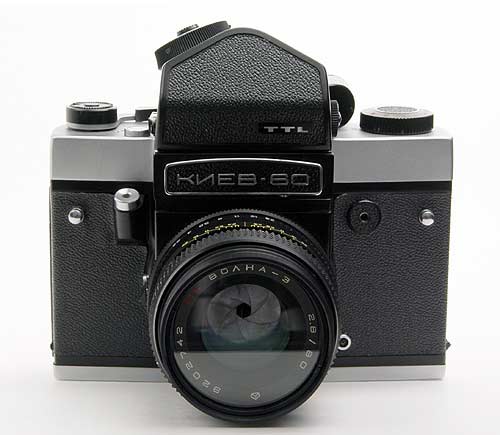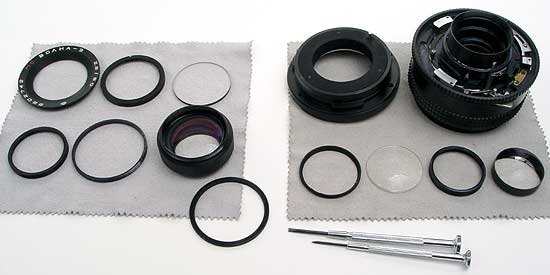Kiev 60/645 [1984]Russian Roulette:
I don't know what possessed me. I'd read all over the web that I should avoid the Kiev medium format SLR's unless I was looking for an exercise in frustration. I'd also read that if I must indulge my FSU camera fetish in one of these monsters then I should spend the extra money on a reworked Hartblei, KievCamera, KievUSA or Arax-photo example of the Kiev 60. Then, one day while aimlessly browsing through eBay, I stumbled upon, and won, this big SLR from the former Soviet Union in the less common 645 format . It's not a Hasselblad, but it's a SLR that produces pretty big negatives for not much money. How much? $70 shipped ($57 for the camera, $12 for shipping). Funny; I'd been avoiding those auctions where the seller is in the Ukraine selling $30 cameras because the shipping was $40-50. Some how it was more acceptable to me if the camera costs more and the shipping less, even though the total cost was probably the same. I think I assumed that if the Camera was already in the US then there was a better chance of getting the camera and of it actually working. This theory was reinforced by the fact that this example was a 645 version of the Kiev 60 which is more typically found in the 6x6 format. As no cameras actually left the factory in the 6x4.5 configuration all non-square examples of the Kiev 60 have been worked on at some point after having left the Arsnell factory. I assumed that, this being the case, again I had more chance of receiving a working camera. When this monster finally arrived it was in a nice looking hard case to hold all the kit which included a waist level finder, prism finder and a couple of filters. Actually, the standard kit should also include a strap, flash bracket and lens hood but I wasn't too worried. Then I checked out the camera. The case was covered in dust paying testament to how long this camera had been left standing. Old mechanical cameras are like old cars; they need to be regularly exercised or they will start to sulk and malfunction. Horror of horrors; this camera had been left cocked. If you are ever going to leave a camera unused for any length of time take out the batteries and make sure the shutter is not cocked. Why? Because when the shutter is cocked everything is put under tension where as when the shutter is tripped the camera's mechanism is more relaxed. As I feared, the camera tipped the first time but from then on the film advance was dicey. The shutter worked ok but the mechanism to catch the mirror and hold it down prior to taking a shot didn't always look the mirror down. In addition the film counter didn't count. This might seem insignificant but the Kiev 60's film advance is delicate at the best of times. It mechanically compensates for the thickness of exposed film on the take-up spool. The 60 is notorious for film spacing problems so the film counter mechanism not functioning could indicate a reasonably serious problem. Certainly one that need to be fixed. Before I could get to the film winding mechanism though I had to clean up the problem with the lens aperture. It was a little reluctant to move, either to stop down or to spring open - both of which are important processes in the picture taking process. Examining the lens in good light revealed a little oil on the aperture blades. I was hoping to avoid this kind of disassembly on what was advertised as a perfect working example. For a moment I was tempted to cast the camera back on to eBay and let someone else take on its problems but a few minutes with some basic tools showed how easy this lenses construction was and, within a couple of hours, I had washed the offending iris blades in lighter fluid, dried, cleaned and reassembled the lens. Lighter fluid dissolves oil on shutters and irises without damage.
So what is the 60 like to own? It looks like an old chrome, 35mm, mechanical SLR that's been hit by an ugly stick ... a lot. Perhaps all this hitting accounts for its reliability problems. It is heavy and awkward to handle - almost too heavy and awkward to hand-hold. It shutter and mirror noise have been likened to a toaster going off. Some have also described the camera as the Yugo of medium format SLR's. That doesn't seem fair. Let's face it, the Pentacon 6 upon which the 60 is based was not overly reliable in the first place. The 60 is not a Hasselblad nor does it pretend to be so. It's not even pretending to be a Mamiya or Bronica. You'd be foolish to rely on this camera for wedding or event photography but if you're an enthusiastic amateur who doesn't mind tinkering and you're tired of trying to frame things in the reverse world of a TLR chimney then the Kiev 60 might be worth considering. On the plus side, if you know your way around a mechanical 35mm SLR the Kiev 60 is going to seem mighty familiar. Also, lenses are available for the Kiev 60 at very good prices allowing you to expand your system for a very modest outlay. There's even a superb 30mm fisheye available for the 60 (a rare thing in the medium format world) for less than $200. This lens alone almost makes owning the Kiev 60 worth while. TipsRTFM 1 - When I first got my camera I decided that the latch release for the film door was broken. Why? Because when I pulled the little release switch on the camera's base, back the camera door did not open. It was only after I removed the camera's base plate did I discover that once you pull the switch back you then have to push it down to open the back. This is one more excursion with the jeweler's screw drivers I could have avoided if only I read the manual instead of assuming I knew how to operate every camera without having instruction. RTFM 2 - I made a similar fool of myself with the light meter that is built into the prism. I couldn't understand why changing the aperture dial on the meter had no effect on the reading. I had decided that my meter was broken before I worked out that only the aperture ring on the lens itself would have any effect on the meter reading. The aperture dial on the meter is there to reflect the setting of your lens in a manual, uncoupled way. My procedure for taking a shot using the light meter built into the prism. now I vaguely know what I am doing is as follows:
Metering - people on the web always seem to be moaning about the meter in the Kiev 60's prism. With a little fiddling you can adjust many meters to be almost accurate but if you're using slide film, or metering in less than ideal conditions don't rely on it. Instead, dig out you old hand-held light meter and bring that along. It completes the retro experience as well as giving to much more accurate exposure readings. 654 or 6x6? I would not have gone out of my way to get my Kiev 60 in the 645 format but I am happy with it now I have it. For one thing I get 3 or 4 more shots per roll than you would with the 6x6 format. In addition I don't think that I think in a square format. It takes a little getting used to with "landscape" format being with the camera turned on its side. For that reason it is well suited to portrait work. If you're used to 35mm or any digital camera (except for a medium format camera back) then 645 format may be suited to you too. Calibration - even fresh from the factory most of these cameras need a little work to make them accurate. If you don't want to do this work yourself there are several third party suppliers who will provide you with a pre-calibrated camera for a premium. If you know your way around a jeweler's screwdriver you can do a lot of the work yourself following the detailed instructions at Kiev-a-holic. Street Cred. - this camera will not improve your street cred. among hipsters like a Lomo or Holga will, or among photogs like a Leica or Canikon DSLR will. If you get a working example (or an example working) it might just improve your photography. Buyer Beware - even fresh from the factory the Kiev 60 is not always reliable. Unless you want to fix a camera before using it make sure that the former owner of seller knows that this particular example works. Postage costs of this camera are pretty chunky and you don't want to be sending it back to the Ukraine too often. Links
|
|
All content © 2003-2011 the other Martin Taylor.
